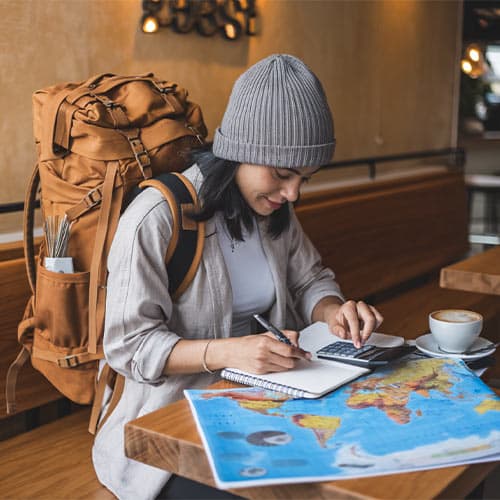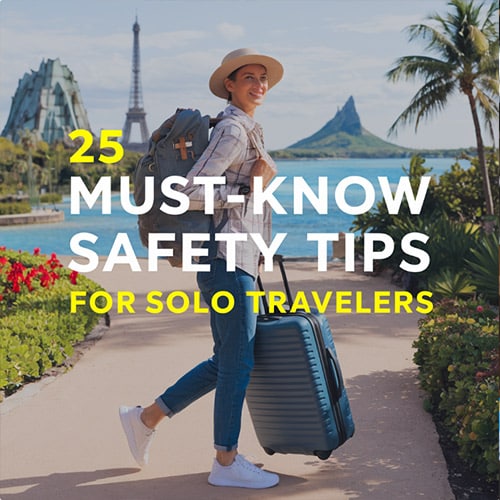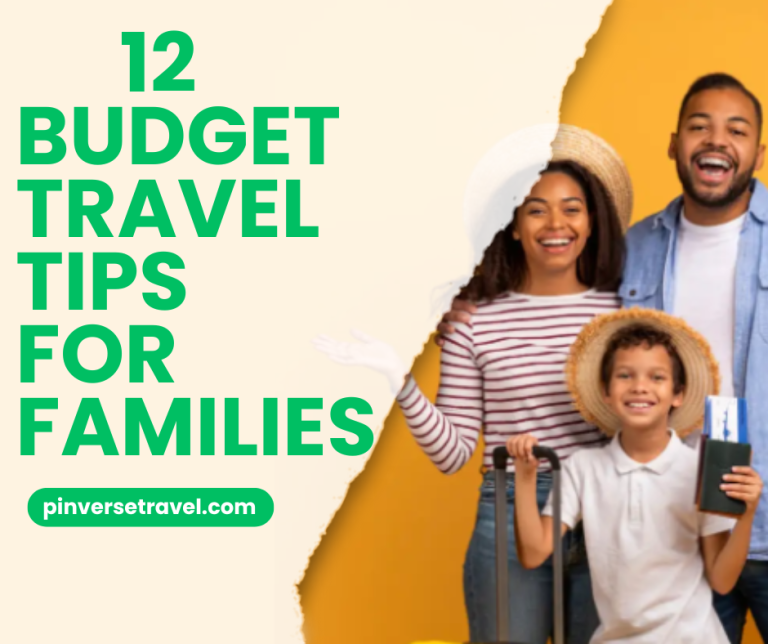How to Create a Solo Travel Budget? Step-by-Step Guide [2025]
Hey there, I’m Emma Collins! If you’re dreaming of solo travel, I get it—exploring the world on your own is thrilling but can also be daunting, especially when it comes to budgeting. As a solo traveler, I’ve learned that planning your budget is key to making your dream trip a reality.
Did you know that a typical solo traveler spends around $50–$100 per day depending on the destination? Creating a budget isn’t just about cutting costs, it’s about maximizing your experience without overspending. In this guide, I’ll show you step-by-step how to create a solo travel budget that suits your goals and helps you stay on track. Let’s get started!
Step-by-Step Guide to Creating a Solo Travel Budget
Did you know that solo travel spending can vary widely depending on factors like destination, travel style, and trip length? Recent surveys show solo travelers spend $50 to $200 per day. It depends on whether they explore budget-friendly spots or indulge in luxury.
Creating a solid travel budget is crucial, especially for solo adventurers. Without the comfort of sharing costs, it’s important to plan ahead. Track every expense. This way, you can enjoy your trip without financial stress.
Step 1: Determine Your Travel Goals and Priorities
Before you dive into numbers, take a moment to think about what you really want from your trip. Are you after adventure, relaxation, culture, or maybe a mix of everything? Your travel goals will shape how you spend your money.
For example, if you’re planning to hike in the Swiss Alps, your focus might be on transportation and gear. If you’re more about soaking up city culture, you might allocate more funds for museums and dining experiences. Knowing your priorities helps you decide where to splurge and where to save.
Step 2: Calculate Available Funds
Once you’ve set your goals, it’s time to figure out how much you can actually spend. Look at your savings and income to get a clear picture of your budget. Make sure to also factor in unexpected expenses, like emergencies or extra travel costs.
If you’re not sure where to start, try setting a target savings amount. For instance, if your trip is three months away, aim to save a specific amount each week. It’ll add up faster than you think!
In my early solo trips, I remember using simple tools like spreadsheets to track what I had and what I needed. That way, I never felt overwhelmed by numbers, and I always knew exactly how much I could spend.
Step 3: Research and Estimate Costs
Before you start booking anything, take time to research the costs at your destination. This means looking into everything from transportation and accommodation to meals and activities. For example, a trip to a major European city like Paris will cost you a lot more than visiting a Southeast Asian destination like Bali. Websites like Numbeo and Budget Your Trip break down daily costs in various cities. They can help you know what to expect to spend. It’s all about knowing where your money will go and preparing accordingly.
Step 4: Choose Budget-Friendly Destinations
One of the easiest ways to control your solo travel budget is to choose budget-friendly destinations. Southeast Asia, Central America, and Eastern Europe often have lower costs for food, lodging, and activities. To stretch your budget, consider less touristy spots. They may be cheaper but just as rich in experience. You’ll be surprised by how many hidden gems are waiting to be explored on a budget!
Step 5: Use Tools and Resources for Budgeting
There are so many tools at your fingertips to help manage your solo travel budget. Budgeting apps like Mint and Trail Wallet, and cost estimators like Rome2Rio, can help track expenses. Set up a simple spreadsheet or use apps to monitor your spending in real-time. It lets you stick to your plan and adjust as needed. This way, you can stay within your budget without the stress of manual tracking.
Why Creating a Solo Travel Budget is Important
When I first started traveling alone, I didn’t fully grasp just how essential a solid travel budget would be. At first, I thought, “I’ll just go, and I’ll figure it out along the way!” But soon enough, I realized that a little planning ahead could make all the difference. A solo travel budget is a financial plan that helps you organize your money before and during your trip. It’s about figuring out how much you can spend. Then, use that money wisely to cover flights, accommodation, food, and activities.
What is a Solo Travel Budget?
A solo travel budget is essentially a financial framework for your trip. It’s a way to map out how much money you need to save, how to allocate your funds, and how to make sure you don’t overspend. Set clear limits for every aspect of your trip. Know how much to spend on transportation, lodging, meals, and entertainment. This helps you avoid financial surprises and ensures you stay within your limits.
How to Stick to Your Solo Travel Budget
Sticking to a solo travel budget can be tricky, especially when you’re in the moment, exploring new places and having fun. But trust me, staying on track is entirely possible with a little discipline and the right tools. I’ve learned the hard way that keeping an eye on your spending not only makes your trip more enjoyable but also ensures you won’t come home to a mountain of debt. Here’s how you can stay within your budget and still make the most out of your solo travels.
Use a Travel Budgeting App
One of the easiest and most effective ways to stick to your solo travel budget is by using a travel budgeting app. These apps help you track your expenses in real-time, categorize your spending, and keep everything organized.
I can’t recommend using apps like Travel Mapper or Trail Wallet enough. In Bali, I used Trail Wallet to log every expense. This included my cheap morning coffee and an exciting surf lesson I splurged on. The app made it simple to see where my money was going, and I could easily adjust if I was over-spending in one category.
Most of these apps let you set daily spending limits, so you’ll know right away if you’re approaching your budget. It’s like having a personal accountant in your pocket, helping you stay on track without being overly restrictive. Plus, they give you a breakdown of where your money is going, so you can make adjustments as you go.
Prioritize Spending
When you’re traveling solo, it’s easy to get caught up in the excitement of all the activities, food, and experiences. But remember, you’re in control of how much you spend. Prioritizing your spending will help you focus on what’s truly important to you, and prevent overspending on things you don’t need.
For example, I’ve always prioritized cultural experiences over expensive meals. During my trip to South America, I decided to skip some of the pricey restaurants in favor of more local, affordable food. Instead, I used the extra money to do something like a guided tour through ancient ruins or take a cooking class where I learned how to make local dishes. This way, I felt like I was truly immersing myself in the culture without draining my wallet.
Another thing I’ve done to stick to my budget is prioritize experiences over material things. When I was in Italy, I resisted the temptation to buy souvenirs at every stop. Instead, I opted to take photos and create memories that were much more meaningful—and I didn’t have to spend extra on trinkets I didn’t really need.
Avoid Common Money Pitfalls
There are a few common traps that can easily derail your solo travel budget. By being aware of these pitfalls, you can avoid making costly mistakes along the way.
1. Overspending on Food & Drinks
It’s easy to get carried away when it comes to food, especially when you’re trying new dishes or treating yourself. I’ve been guilty of dining out for every meal, but quickly realized that it adds up. To keep my budget in check, I started shopping at local markets for fresh fruit, snacks, and ingredients to make simple meals. Not only did I save money, but I also got to experience a more authentic side of the places I visited.
2. Not Budgeting for Transportation
When I first traveled solo, I didn’t account for transportation costs. I would jump in cabs or take trains without thinking much about the cost. This can add up quickly, especially in big cities. I’ve learned to check for transport passes or even walk whenever possible. For instance, in Barcelona, I bought a multi-day metro pass, which saved me a ton of money compared to paying for single tickets every time.
3. Hidden Costs
Beware of hidden costs, like booking fees and tourist taxes. They can sneak up on you. On my trip to Prague, I was surprised by the small but unexpected fees for using certain public restrooms (yep, they charge for those!). I now budget for these small expenses in advance, so they don’t catch me off guard.
4. Being Too Spontaneous
Spontaneity is a big part of traveling solo, and I love it. However, I’ve learned that sometimes, making last-minute decisions can cost more than planned activities. For example, I once booked a last-minute tour in New Zealand, and because it was spur-of-the-moment, the price was much higher than if I’d booked in advance. Now, I try to plan some activities ahead of time while leaving space for some spontaneity.
5. Overestimating Free
Attractions I’ve visited many free attractions while traveling. Some had hidden costs, like entrance fees for parts of a park or museum. A great example was when I went to the British Museum in London. It’s free to enter, but some exhibits had paid entry. It’s important to research free attractions thoroughly to avoid any surprises.
Sticking to your solo travel budget isn’t about depriving yourself. It’s about making smarter choices. They will let you travel longer, stress-free, and more comfortably. I’ve found that, by tracking my spending and using travel apps, I can explore the world without money worries. I prioritize experiences and avoid common financial pitfalls. It’s all about striking the right balance between enjoying the moment and being mindful of your budget. Happy travels!
Tips for Saving Money on Solo Travel
Solo travel is a rewarding experience, but let’s face it—traveling can be expensive. The good news is that there are plenty of ways to cut costs without compromising the quality of your experience. After years of solo travel, I’ve picked up some smart tips for saving money on transportation, accommodation, food, and activities. These tips helped me stretch my budget further, giving me more opportunities to explore. Here’s how you can save while traveling solo.
Save on Transportation
Transportation is often a major travel expense, especially when city or country hopping. But don’t worry, there are ways to make it more affordable.
1. Use Public Transportation: In most cities, public transportation is the most budget-friendly option. When I was in Berlin, I relied on the metro and buses instead of taking taxis. It saved me a lot, and I got to experience the city like a local. Many cities also offer day passes that allow unlimited travel, which is a great deal if you’re planning to explore a lot.
2. Walk or Rent a Bike: Walking is not only free but a great way to see a city up close. In Copenhagen, I rented a bike for a very low price, which allowed me to explore the city at my own pace. Many places have bike-sharing programs that make it easy to rent for just a few hours.
3. Book Trains or Buses in Advance: If you need to travel between cities, booking train or bus tickets in advance can save you a lot of money. I once traveled from Amsterdam to Paris on a budget bus that cost me only 30 euros because I booked a few weeks ahead. The earlier you book, the better the prices.
4. Use Ride-Sharing: If public transport isn’t convenient, try Uber or Lyft. They’re often cheaper than taxis. I’ve used ride-sharing apps in places like Mexico City, where fares were much lower than traditional taxis.
Save on Accommodation
Accommodation is a big travel cost. But, there are many ways to find affordable, comfortable places to stay.
1. Stay in Hostels or Guesthouses: Hostels aren’t just for backpackers anymore. Many hostels offer private rooms at a fraction of the cost of hotels, and they provide great opportunities to meet other travelers. I stayed in a charming guesthouse in Lisbon. It cost me 20 euros a night. It had everything I needed: free Wi-Fi, clean rooms, and a kitchen to cook my meals.
2. Use Accommodation Platforms: Websites like Airbnb and Booking.com are great for finding unique, cheap places to stay. I’ve stayed in everything from cozy apartments to treehouses, all for less than the price of a hotel. You can filter for budget options. Sometimes, you can negotiate a better price for longer stays.
3. Look for Discounts and Deals: Before booking, always check for special deals or discounts. I often use websites like Skyscanner or Kayak to compare prices and find the best deals on rooms. Signing up for hotel reward programs or using cashback services like Rakuten can also help you save.
4. Consider Couchsurfing: If you’re really trying to save, you can try Couchsurfing, where you stay for free with locals. It’s not only cost-effective but also a great way to meet people and get insider tips about your destination.
Save on Food
Food is a major part of your travel experience, but that doesn’t mean you have to break the bank. Here’s how I save money while still enjoying delicious meals:
1. Eat Like a Local: Instead of dining at expensive tourist spots, look for places where locals eat. In Chiang Mai, Thailand, I found street food stalls where I could get delicious and authentic dishes for just a few dollars. Not only was it cheap, but it was also the best food I had on the entire trip.
2. Cook Your Own Meals: If you’re staying in a hostel or Airbnb with a kitchen, consider cooking your own meals. I’ve made simple meals like pasta, salads, and sandwiches, which saved me a lot of money over time. It’s also a fun way to experiment with local ingredients and save money.
3. Take Advantage of Local Markets: Grocery stores and farmers’ markets are great places to pick up snacks, fresh produce, or quick meals. In Barcelona, I went to La Boqueria Market. I could buy fresh fruit, bread, and cheese there for a fraction of the price of eating at a restaurant.
4. Look for Special Offers: Many restaurants offer daily specials or lunch menus at discounted prices. I’ve found that going for a “set menu” or “prix-fixe” option can be a great way to enjoy a full meal at a lower cost.
Save on Activities
Solo travel is all about experiencing new things, but activities can get pricey. Here’s how you can have fun and stay within your budget:
1. Take Advantage of Free Activities: Many cities offer free or low-cost activities. In London, I visited museums like the British Museum and National Gallery, which had no entry fee. I also took free walking tours, where the guides worked for tips (and they were fantastic!). These free activities can be just as fulfilling as paid ones.
2. Look for Discount Passes: Many cities have tourist discount passes. They provide cheaper access to several attractions. For example, I used the Paris Museum Pass, which allowed me to skip the lines and visit several museums for a fixed price, saving both time and money.
3. Plan and Book in Advance: Sometimes, booking activities ahead of time can save you money. I’ve found discounts for activities like boat tours, cooking classes, and guided hikes when I booked them online before my trip. If you know what you want to do, securing a spot in advance can help you avoid paying full price.
4. Go for Nature Activities: If you’re on a tight budget, nature activities are often free or very cheap. Hiking, swimming in lakes or oceans, and exploring parks are all great options. I went hiking in the Swiss Alps and had one of the best experiences of my life without spending a cent.
By following these tips, you’ll not only save money but also find new ways to enjoy your solo travels without stressing about the budget. The key is to plan ahead, be flexible, and keep an eye out for affordable options. Solo travel doesn’t have to be expensive—it’s all about smart choices and making the most of every opportunity that comes your way. Happy travels!
Final Thoughts
Solo travel is a life-changing experience, and budgeting plays a huge role in making it happen. It’s not about how much you spend, but how wisely you spend it. Plan ahead, use budgeting tools, and prioritize expenses. You can enjoy your trip without financial stress.
Through my own travels, I’ve learned that every adventure, big or small, is worth it when you manage your budget right. It’s the freedom and the self-discovery that make solo trips unforgettable.
So, take that leap, plan smartly, and let the world be your playground. Your next adventure awaits!


![The Ultimate Guide to Backpacking: Gear, Tips, and Planning [2025]](https://pinversetravel.com/wp-content/uploads/2024/11/Ultimate-Guide-to-Backpacking-Gear-Tips-and-Planning--768x431.jpeg)


